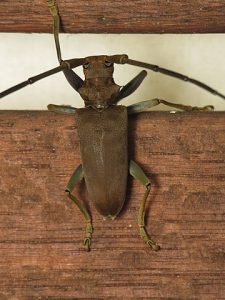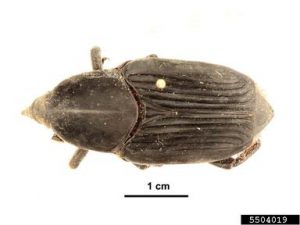
California Pest Rating for
Palm mealybug | Palmicultor palmarum (Ehrhorn)
Hemiptera: Pseudococcidae
Pest Rating: A
PEST RATING PROFILE
Initiating Event:
Palmicultor palmarum is currently Q-rated. A pest rating proposal is required to support an official pest rating.
History & Status:
Background: Palm mealybugs are slow moving, piercing-sucking insects that feed on plant sap and are usually found in clusters along leaf veins, on the undersides of leaves, and in hidden areas at joints. These insects exude honeydew that becomes infested by sooty mold and gives the leaves a dirty appearance. Ants may be attracted to the honeydew. Plants infested with mealybugs become weak and may eventually die3.
Known hosts include: Arecaceae: Areca catechu, Borassus flabellifer, Caryota mitis, Cocos nucifera, Dypsis lutescens, Elaeis guineensis, Hyophorbe indica, Phoenix roebelenii, Roystonea regia, Washingtonia filifera, Licuala spp. & Thrinax spp.; Pandanaceae: Freycinetia spp.; Fabaceae: Acacia asak; Poaceae: Phyllostachys spp.1, 5.
Worldwide Distribution: Palmicultor palmarum was described from Hawaii and has been introduced to many places in the world, including much of the Caribbean islands, the Bahamas, India, Bangladesh, Indonesia, Malaysia, Maldives, New Caledonia, Niue, China, Mexico, and Florida in the continental United States 1.
Official Control: Palmicultor palmarum is listed as a harmful organism by the Republic of Korea and Egypt6.
California Distribution: Palmicultor palmarum has never been found in the environment in California.
California Interceptions: Palmicultor palmarum was found in 2017 at a nursery in San Diego County (PDR 370P06678075 & 370P06678076). It has been intercepted 53 times since 19904.
The risk Palmicultor palmarum (palm mealybug) would pose to California is evaluated below.
Consequences of Introduction:
1) Climate/Host Interaction: Host plants of Palmicultor palmarum are mostly palm trees, and this species appears to be restricted to areas with a tropical/subtropical climate; it is possible that it may become established in a limited portion of southern California. Therefore, Palmicultor palmarum receives a Low (1) in this category.
Evaluate if the pest would have suitable hosts and climate to establish in California:
– Low (1) Not likely to establish in California; or likely to establish in very limited areas.
– Medium (2) may be able to establish in a larger but limited part of California.
– High (3) likely to establish a widespread distribution in California.
2) Known Pest Host Range: Palmicultor palmarum has been reported to feed on plants of at least fifteen genera in four families. Therefore, it receives a Medium (2) in this category.
Evaluate the host range of the pest.
– Low (1) has a very limited host range.
– Medium (2) has a moderate host range.
– High (3) has a wide host range.
3) Pest Dispersal Potential: Scale insects have high reproductive rates and may disperse long distances when infested plants or plant parts are moved. Palmicultor palmarum frequently moves long distances in the trade of infested palm trees. Therefore, it receives a High (3) in this category.
Evaluate the natural and artificial dispersal potential of the pest.
– Low (1) does not have high reproductive or dispersal potential.
– Medium (2) has either high reproductive or dispersal potential.
– High (3) has both high reproduction and dispersal potential.
4) Economic Impact: Palmicultor palmarum could reduce the value of nursery stock by disfiguring plants with its presence and increasing crop production costs in nurseries. It is not expected to change cultural practices, vector other organisms, injure animals, or disrupt water supplies. It receives a Medium (2) in this category.
Evaluate the economic impact of the pest to California using the criteria below.
Economic Impact: B, C
A. The pest could lower crop yield.
B. The pest could lower crop value (includes increasing crop production costs).
C. The pest could trigger the loss of markets (includes quarantines).
D. The pest could negatively change normal cultural practices.
E. The pest can vector, or is vectored, by another pestiferous organism.
F. The organism is injurious or poisonous to agriculturally important animals.
G. The organism can interfere with the delivery or supply of water for agricultural uses.
Economic Impact Score: 2
– Low (1) causes 0 or 1 of these impacts.
– Medium (2) causes 2 of these impacts.
– High (3) causes 3 or more of these impacts.
5) Environmental Impact: Palmicultor palmarum is not expected to lower biodiversity, disrupt natural communities, or change ecosystem processes. It might trigger new chemical treatments in orchards and the nursery industry and by residents who find infested plants unsightly. It is not expected to significantly impact cultural practices, home/urban gardening, or ornamental plantings. It receives a Medium (2) in this category.
Evaluate the environmental impact of the pest on California using the criteria below.
Environmental Impact: D
A. The pest could have a significant environmental impact such as lowering biodiversity, disrupting natural communities, or changing ecosystem processes.
B. The pest could directly affect threatened or endangered species.
C. The pest could impact threatened or endangered species by disrupting critical habitats.
D. The pest could trigger additional official or private treatment programs.
E. The pest significantly impacts cultural practices, home/urban gardening or ornamental plantings.
Environmental Impact Score: 2
– Low (1) causes none of the above to occur.
– Medium (2) causes one of the above to occur.
– High (3) causes two or more of the above to occur.
Consequences of Introduction to California for Palmicultor palmarum (Palm mealybug): Medium (10)
–Low = 5-8 points
–Medium = 9-12 points
–High = 13-15 points
6) Post Entry Distribution and Survey Information: Palmicultor palmarum has never been found in the environment in California and receives a Not Established (0) in this category.
Evaluate the known distribution in California. Only official records identified by a taxonomic expert and supported by voucher specimens deposited in natural history collections should be considered. Pest incursions that have been eradicated, are under eradication, or have been delimited with no further detections should not be included.
–Not established (0) Pest never detected in California, or known only from incursions.
–Low (-1) Pest has a localized distribution in California, or is established in one suitable climate/host area (region).
–Medium (-2) Pest is widespread in California but not fully established in the endangered area, or pest established in two contiguous suitable climate/host areas.
–High (-3) Pest has fully established in the endangered area, or pest is reported in more than two contiguous or non-contiguous suitable climate/host areas.
Final Score:
The final score is the consequences of introduction score minus the post entry distribution and survey information score: Medium (10)
Uncertainty:
There have not been any recent surveys for Palmicultor palmarum. It is possible that it could be present in coastal parts of the state.
Conclusion and Rating Justification:
Palmicultor palmarum is not known to be present in California. If it became established here, it could have a significant impact on the ornamental palm industry ($70 Million industry in California – Hoddle.) 2 Therefore, an “A” rating is justified.
References:
- García Morales, M., Denno, B.D., Miller, D.R., Miller, G.L., Ben-Dov, Y., and N.B. Hardy. Scale Net: A literature-based model of scale insect biology and systematics. Database. doi: 10.1093/database/bav118. Accessed on 12/18/2017. http://scalenet.info/catalogue/Palmicultor%20palmarum/
- Hoddle, M. Has the South American palm weevil, Rhynchophorus palmarum, established in southern California? University of California, Riverside, Center for Invasive Species Research. Accessed on 12/18/2017. http://cisr.ucr.edu/palmarum.html
- Missouri Botanical Garden. Online, Accessed on 12/18/2017. http://www.missouribotanicalgarden.org/gardens-gardening/your-garden/help-for-the-home-gardener/advice-tips-resources/pests-and-problems/insects/mealybugs/mealybugs-indoors.aspx
- Pest and Damage Record Database, California Department of Food and Agriculture, Plant Health and Pest Prevention Services. Accessed on 12/18/2017. http://phpps.cdfa.ca.gov/user/frmLogon2.asp
- Stocks, I. 19: Recent Adventive Scale Insects in Florida and the Caribbean Region. pp. 346-347. CABI. Accessed on 12/18/2017. https://www.cabi.org/ISC/FullTextPDF/2013/20133231104.pdf
- USDA phytosanitary Certificate Issuance & Tracking System (PCIT) Phytosanitary Export Database (PExD). Accessed on 12/18/2017 https://pcit.aphis.usda.gov/pcit/
Author:
Javaid Iqbal, California Department of Food and Agriculture; 1220 N Street, Sacramento, CA 95814; Tel. (916) 403-6695; plant.health[@]cdfa.ca.gov.
Responsible Party:
Jason Leathers, 2800 Gateway Oaks, Sacramento CA 95833, (916) 654-1211, plant.health[@]cdfa.ca.gov
Comment Period:* CLOSED
3/16/18 – 4/30/18
*NOTE:
You must be registered and logged in to post a comment. If you have registered and have not received the registration confirmation, please contact us at plant.health[@]cdfa.ca.gov.
Comment Format:
♦ Comments should refer to the appropriate California Pest Rating Proposal Form subsection(s) being commented on, as shown below.
Example Comment:
Consequences of Introduction: 1. Climate/Host Interaction: [Your comment that relates to “Climate/Host Interaction” here.]
♦ Posted comments will not be able to be viewed immediately.
♦ Comments may not be posted if they:
Contain inappropriate language which is not germane to the pest rating proposal;
Contains defamatory, false, inaccurate, abusive, obscene, pornographic, sexually oriented, threatening, racially offensive, discriminatory or illegal material;
Violates agency regulations prohibiting sexual harassment or other forms of discrimination;
Violates agency regulations prohibiting workplace violence, including threats.
♦ Comments may be edited prior to posting to ensure they are entirely germane.
♦ Posted comments shall be those which have been approved in content and posted to the website to be viewed, not just submitted.
Pest Rating: A
Posted by ls



